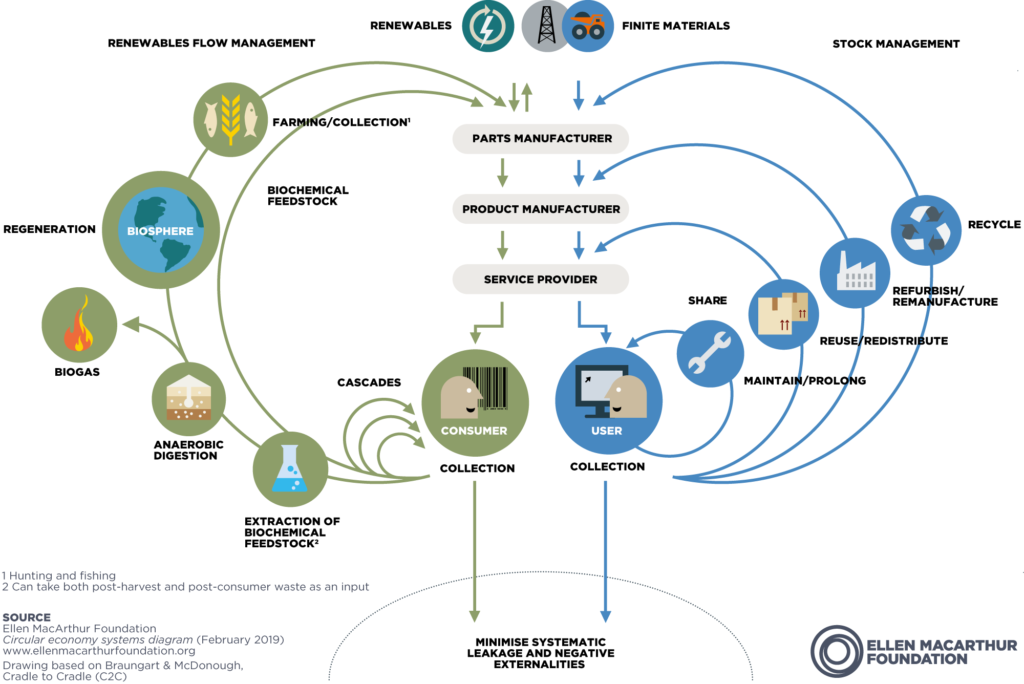Circular economy refers to a form of economy that is fundamentally regenerative and operates in cycles. Primarily, this idea refers to the raw materials used for the production of the products we consume – this also includes our food. But this idea also has other implications: The burning of fossil fuels is not regenerative and for this reason has no place in a circular economy. The circular economy is born out of the idea of maximising the social benefits of raw materials. This is only possible if social society also has equal access to resources and products.
Table of Contents
- Ellen MacArthur Foundation
- Circular Economy Concepts
- Circular Economy in the EU
- Ideal vs. Real – Why it is not possible to recycle 100 % with today’s circular economy systems.
- Posts about Circular Economy
Ellen MacArthur Foundation
The circular economy is based on 3 principles according to the Ellen MacArthur Foundation, which is strongly committed to education in this field:
Design out waste and pollution.
Design out waste and pollution.
Ellen MacArthur Foundation
This means that the “End of Life” (EoL) must already be known when designing products. This is the only way to ensure that the product does not become waste, but is given a new life. Furthermore, products must be designed in such a way that they do not emit harmful substances during production, use and disposal.
Keep products and materials in use.
Keep products and materials in use.
Ellen MacArthur Foundation
From this statement we can see that this is particularly about avoiding waste and costly recycling steps. In the article on the waste pyramid, you can read why it is important to avoid waste in the first place. The best way to do this is to use products and materials as efficiently as possible and keep them in use, rather than buying something new because the model is no longer the latest.
Regenrate natural systems.
Regenrate natural systems
Ellen MacArthur Foundation
Here we can see particularly clearly that the circular economy is not only concerned with minimising damage, but also with repairing damage. In concrete terms, it is our task to help nature, which has been partially destroyed by humans, to regenerate itself.
Circular Economy Concepts
Of course, there are various perspectives and concepts on how such a circular economy can be built up sustainably. I would like to briefly introduce the most important and well-known ones here and possibly go into more detail later.
Cradle to Cradle®
The Cradle to Cradle® design framework is inspired by nature: The aim is not only to minimise negative influences but also to leave a positive ecological footprint. As a result, products, processes, buildings and cities will emerge which are safe for humans, healthy for the environment and successful for business.
EPEA
The Cradle to Cradle® principle is a joint development of the German chemist Michael Braungart and the US architect William McDonough. Cradle to Cradle® meansexactly what the name says: “from the cradle to the cradle”. Appropriately this means that raw materials at the end of one life cycle are again at the beginning of another life cycle and thus must not be degraded. It is therefore necessary to keep raw material cycles separate from each other, but also to make a clear separation within raw material cycles. This can best be explained with the following diagram from the Ellen MacArthur Foundation:

Two cycles are needed, which contain different categories of raw materials. The natural cycle contains renewable resources, i.e. materials that can be regenerated within a few years to decades. Raw materials in this category are referred to as “biological nutrients” in the Cradle to Cradle® design principle. Materials that can wear out in nature are kept in this cycle. So this includes your jeans, the soles of your shoes, the tyres of your bike or car and the bristles of your toothbrush. All of these products are subject to wear and tear and (in the conventional case) may release pollutants or at least particles that do not belong in the environment or in your body.
The technical cycle contains all those products that are made of materials that cannot be replaced by natural materials, or only at a loss of quality, and that do not wear out in nature, or only to a limited extent. These raw materials are called “technical nutrients” in the Cradle to Cradle® design principle. An example of this is your computer and other IT equipment, your washing machine or the frame of your bicycle. The technical cycle requires a different way of handling the materials, which makes it possible to use the products for as long as possible. For example, components can be particularly resistant or repairable, or you can use leasing or rental systems in which the products (and thus also the raw materials) are returned to the manufacturing company after use and/or are used with particularly high frequency.
Circular Economy in the EU
The EU Commission presented an Action Plan for the Circular Economy to the EU Parliament on 11 March 2020. It contains advice on sustainable product design, and focuses specifically on reducing waste from resource-intensive sectors (electronics, textiles, construction, batteries and vehicles, packaging, plastics and food as well as nutrients). Along the way, consumer protection is also increased – for example through a “right to repair”.
This action plan was then adopted by the EU Parliament on 10 February 2021, with the addition of the goal “to achieve a CO₂-neutral, environmentally sustainable, toxin-free and fully circular economy by 2050 at the latest”.
The first package of measures was then adopted in March 2022: Sustainable products will be promoted, the green transition will be supported, the Construction Products Regulation will be revised and a strategy for sustainable textiles will be introduced.
A summary of the circular economy from the perspective of the EU Parliament can be found here.
Ideal vs. Real – Why it is not possible to recycle 100 % with today’s circular economy systems.
Cradle to Cradle® is a principle that in theory makes it possible to recover 100% of our raw materials. However, methods used worldwide do not achieve this goal even with optimal efficiency. This is because most products in today’s global economy are not designed for EoL (“End of Life”). This means that raw materials are mixed, raw materials end up in the wrong environment and become toxins (more on this in the article on Cradle to Cradle®) and there is no Extended Producer Responsibility (EPR).
Posts about Circular Economy
The pyramid of waste
For a general understanding of the circular economy and why concepts such as Cradle to Cradle are necessary at all, we will look at the waste pyramid in this article. This shows the hierarchy of concepts for reducing waste. The higher up, the more efficient is the use of raw materials, as they can be…
Read more

